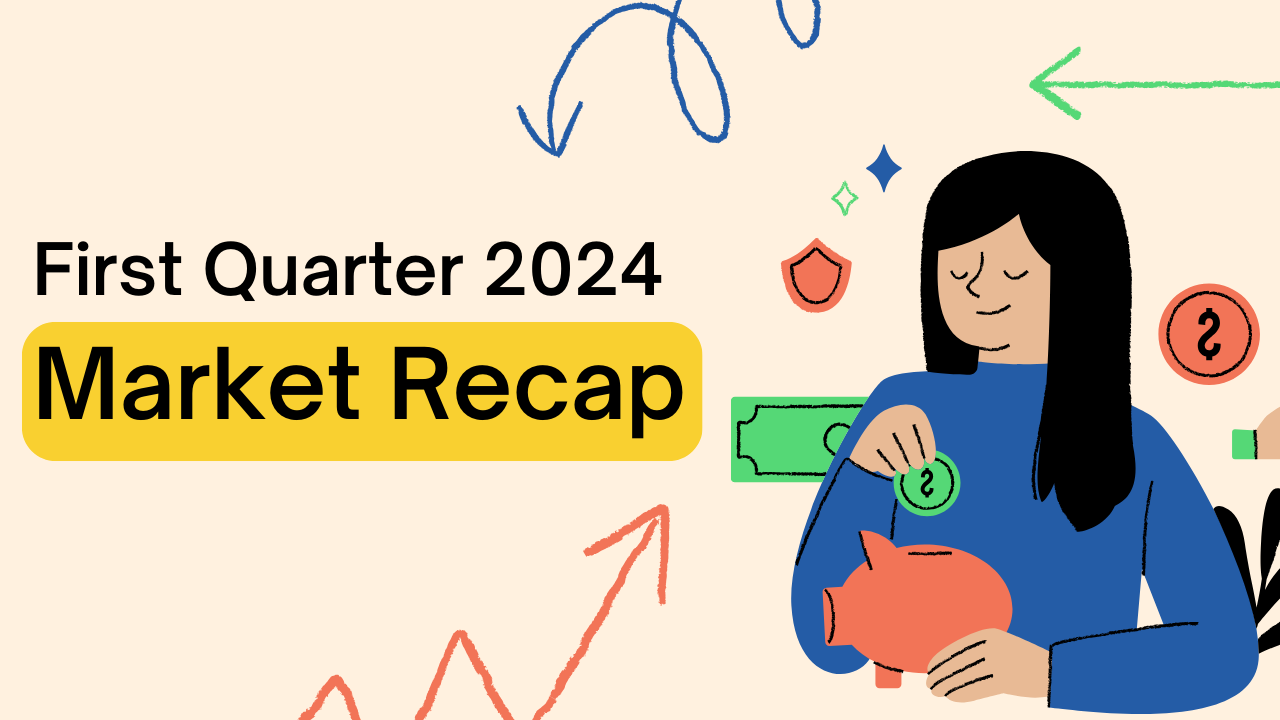
The U.S. Stock market is off to a strong start in 2024. Investors viewed the possibility of recession to be less likely, expectations about the direction of broad economic growth improved, and exuberance about the potential for stronger earnings growth coming from the advancement in artificial Intelligence stirred up a potent cocktail.
Fixed income on the other hand has been a bit frustrating for conservative investors that have resisted the urge to overweight their equity allocation in high growth sectors like tech. Bond holders had a nicely positive return in 2023, but during the 1st quarter of 2024, the performance of interest sensitive income assets has not fared as well.
Stock Market
Each of the benchmark indexes posted solid 1st quarter gains led by the S&P 500 and the Nasdaq. The S&P 500 hit its first record high in two years in early February surpassing the 5,000 mark for the first time, eventually leading to its best first quarter performance since 2019. In fact, the S&P 500 has now had five positive months in a row, a feat it has only achieved 30 times since 1950. In 28 of those instances (or 93% of the time) the index finished higher 12 months later. If history does indeed repeat, the odds favor a positive trend for equities over the next 12 months. (1)
Once again, a large portion of the upward market movement so far in 2024 has been driven by a relatively small percentage of the total companies in the index. The top 10 market cap weighted stocks accounted for about 60% of the quarters advance, though that concentration is somewhat of a moderation from the previous peak. In 2023, the total return of the S&P 500 was very highly concentrated in the top 10 stocks. Looking at data from Investors Business Daily, we can see they accounted for 86% of the 2023 S&P 500 index gain, with the remaining 490 stocks only kicking in 14% of the total. (2) Talk about concentration!
But even if the rest of the year will produce a positive outcome, it seems unlikely the path to that hoped for positive result will be without some added volatility. What might be the catalyst for some of that heightened risk? There are several possible culprits lurking in the wings. We have a Presidential election coming up later this year that is almost sure to provide some fuel to the volatility fire. The Federal Reserve could also provide some excitement if their path of interest rate movements doesn’t match the expectations of economists and market analysts. Last but certainly not least, the rosy earnings growth projections for the rest of 2024 might not turn out to be quite as great as currently priced into an equity market priced for perfection.
Given the mixture of dynamics cited above, we have been prudent in managing concentration risk in equity portfolios, ensuring a good degree of diversification across sector, style and geography.
Bond Market
The Bloomberg U.S. Aggregate Bond Index, the primary benchmark used to track returns of intermediate term, investment-grade fixed income assets, posted a 5.5% return in 2023. (3) The returns were primarily driven by falling long-term U.S. Treasury rates as the 10-year Treasury fell from around 5% to below 3.9% by year end. This was welcome relief to bond investors after suffering declines in the previous two years because of the Federal Reserve’s aggressive campaign to raise interest rates to combat high levels of inflation. (Bond prices are inversely correlated to bond rates. When rates go up, bond prices decline, and vice versa.)
However, the 1st quarter of 2024 proved to be a more challenging period for bonds. Inflation levels have stalled their decline and remain sticky just above the 3% level, which is higher than the Fed’s stated target of 2% annual inflation growth. This factor, combined with more resilient economic reports than expected have caused the Federal Reserve to backpedal somewhat on the more Dovish tone they projected following their December 2023 meeting.
The shift in the macro backdrop was also reflected in market expectations for future interest rate cuts for the balance of 2024. At the start of the year, the implied number of rate cuts was six to seven ¼% cuts, starting in March and taking the Fed’s target interest rate down to 3.5% to 3.75% from the current 5.00% to 5.25%. But that outlook has now dropped to no more than three ¼% rate cuts, starting possibly in June, leaving the Fed’s target interest rate by year-end at 4.00% to 4.25%. (4) As a result, the yield on the 10-year U.S. Treasury bounced from its year-end low to end the quarter at 4.35%, pushing bond prices lower.
But there is good news for conservative investors that have a diversified portfolio that includes good quality, intermediate term income instruments. These assets are more fairly priced today than at the end of last year and offer more attractive yields than at any time in the last decade. An allocation to bonds appropriate for the risk tolerance and long-term objectives of each investor should help cushion the portfolio performance in case of an adverse growth shock to the equity market.
The balance of the year the investment markets may become more focused on election campaign rhetoric, corporate earnings growth and the on-going turmoil in Ukraine and the Middle East. Only time will tell. One thing however is certain. In the investment markets, change is the only constant.
Footnotes:






